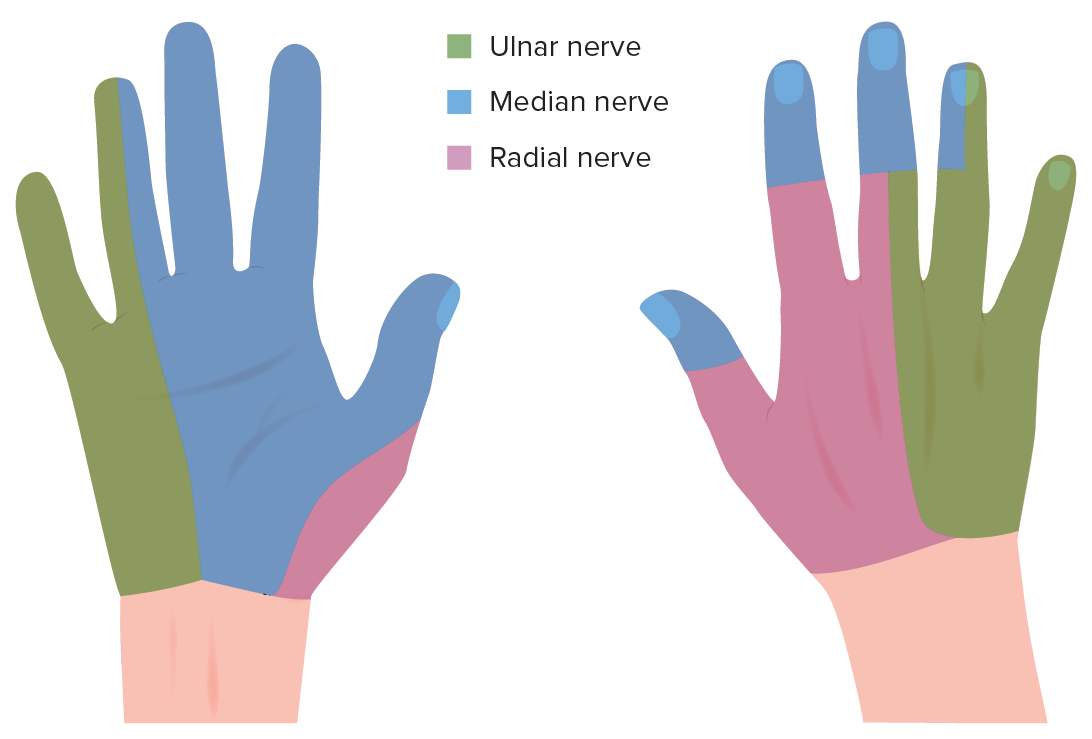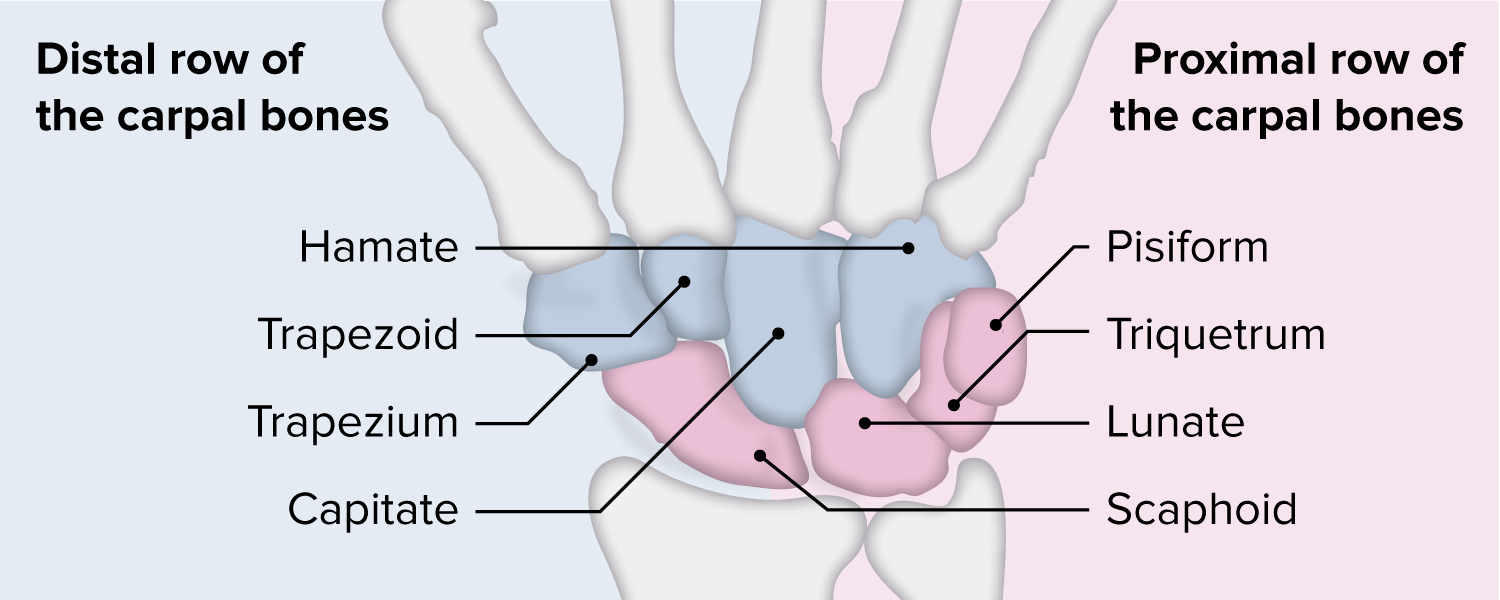Playlist
Show Playlist
Hide Playlist
Hand – Bones and Surface Anatomy of Upper Limb
-
Slides 01 UpperLimbAnatomy Pickering.pdf
-
Download Lecture Overview
00:00
Okay. We now move into
the hand. Then we can
see we have a whole series of bones which are
forming the wrist joint here. These are
known as carpal bones. We can see on the
picture, we then have five metacarpals we can
see running down in this direction. And then
we can see we have phalanges that give rise
to digits. So let’s just look at the carpals
first of all. And there are eight carpal bones
and these eight carpal bones form two rows,
with each rows having four carpal bones in
them. And this arrangement, this high number
of bones allows greater flexibility.
00:43
So there is a high level of flexibility within the
wrist joint. Again allowing great movement
of the wrist to assume numerous positions.
We have the proximal row and from lateral
to medial. So here we've got the anterior view
of the right hand. So this is going to be lateral.
01:08
We can see here the first digit, the thumb,
this is lateral and this fifth digit is
medial here. And this proximal row from lateral to
medial, we have these four bones. We have the
scaphoid, we have the lunate, we have the triquetrum
and we have the pisiform bone. And we can see
these here. We can see we have got the scaphoid,
we can see we have the lunate, we can see
we have the triquetrum, and then we can see
we have the pisiform. So 1,2,3,4. These four
bones that form this proximal row. We can
see this on this anterior view and we can also
see them on this posterior view. Again remember the
thumb here is lateral, so from lateral to medial, we have
scaphoid, we have lunate, we have triquetrum
and we have pisiform. These four bones that
make up the proximal row. We also have a distal
row and these are formed by trapezium, trapezoid,
capitate and hamate. And these are the distal
rows and again we can see them from lateral
to medial, we can see the trapezium, we can
see the trapezoid, we can see the capitate
and then we can see the hamate with the hook
of the hamate as a prominent feature.
02:35
We can see this on the anterior aspect, trapezium,
trapezoid, we can see the capitate and then we can
see the hamate bone. So we've got this proximal row
and then we've got this distal row. We have these two rows
with four bones forming each row, while we can see
them both from the anterior and the posterior
view. Here in the posterior view, we can see
trapezium, trapezoid, capitate and hamate.
03:07
And these bones, these 8 carpal bones offer great
flexibility.
03:11
If we look at the palm of the hand, this is
known as the metacarpus, it is formed by
five metacarpals, and these metacarpals
all have a similar feature. The five of them,
they have a base. We can see a base here, here,
here, here and here. And the base of the metacarpals
articulate with the distal row of the carpal
bones. So these five metacarpals, their bases
articulates with the trapezium, the trapezoid,
the capitate and the hamate with the proximal
row of carpal bones articulating with the
radius at the wrist joint. We have a nice
shaft here which we can see and then we have
a head. And the head of the metacarpals form the
knuckles which you can see on your own hand and
these articulate with the proximal phalanges
of the digits. So, each individual metacarpal
will have a base, a shaft and a head.
04:15
The head articulates with the proximal phalanges.
04:19
And let's look at these phalanges. For digits
2, 3, 4 and 5, there are 3 phalanges. So digits
2, 3, 4 and 5, we have 3 phalanges. We have
a proximal, we have a middle and we have
a distal. And each one of these phalanges again
just like a metacarpal is going to have a
base, is going to have a shaft and is going
to have a head. Now digits 2, 3, 4, and 5
have 3 phalanges. Digit 1 only has two. It
just has a proximal and a distal.
05:02
So there we have the various bony features that
make up the hand. The carpals, the metacarpals
and the phalanges.
About the Lecture
The lecture Hand – Bones and Surface Anatomy of Upper Limb by James Pickering, PhD is from the course Upper Limb Anatomy [Archive].
Included Quiz Questions
How many carpal bones are there?
- 8
- 10
- 9
- 7
- 6
What is the correct arrangement of the carpal bones in the proximal row going from the lateral to the medial direction?
- Scaphoid, lunate, triquetrum, and pisiform
- Lunate, scaphoid, triquetrum, and pisiform
- Scaphoid, triquetrum, lunate, and pisiform
- Pisiform, triquetrum, lunate, and scaphoid
- Triquetrum, pisiform, scaphoid, and lunate
Which of the following bones has a prominent hook?
- Hamate
- Scaphoid
- Lunate
- Trapezium
- Capitate
Customer reviews
5,0 of 5 stars
| 5 Stars |
|
2 |
| 4 Stars |
|
0 |
| 3 Stars |
|
0 |
| 2 Stars |
|
0 |
| 1 Star |
|
0 |
good lecture, like the breakdown of structures and in relation to other ones.
1 customer review without text
1 user review without text





